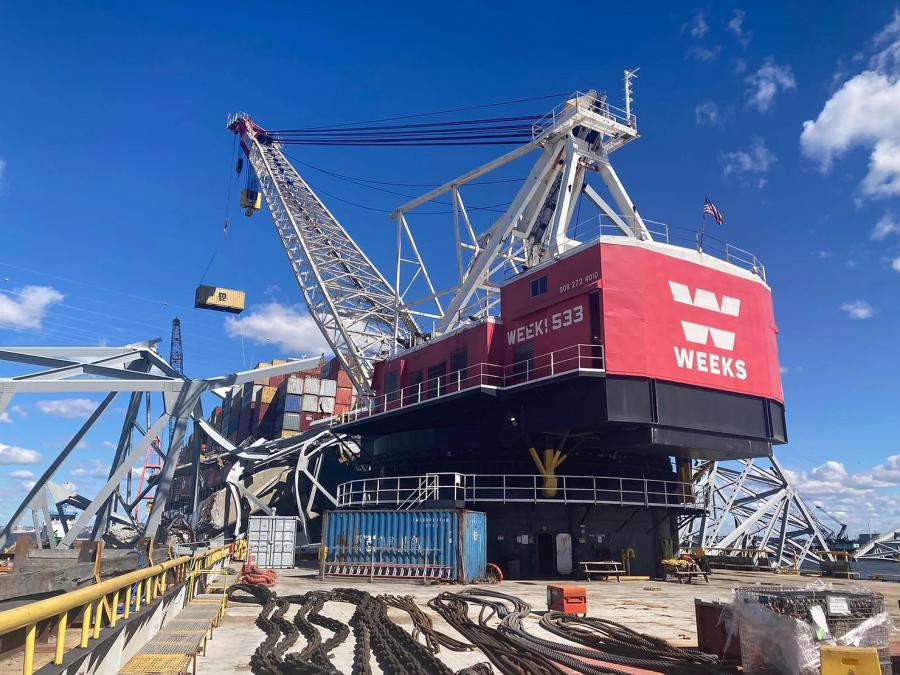
Thu April 18, 2024
CEG Staff
Workers have begun using cranes to offload containers from the Dali, the 100,000-ton vessel that crashed into Baltimore's Key Bridge on March 26, 2024, and sent major sections of the bridge plunging into the waters of the Patapsco River.

U.S. Coast Guard Petty Officer 3rd Class Erin Cox photo
"The Unified Command is progressing on its effort to remove enough debris to open the channel to larger commercial traffic, refloat the M/V Dali and continue recovery efforts for missing loved ones," said Coast Guard Capt. David O'Connell, federal on-scene coordinator, Unified Command. "Every day we are working to achieve these goals efficiently and safely."
As workers move the containers, the Dali should be able to float free and begin the process of opening the channel to the Port of Baltimore, one of the most important shipping points on the East Coast. In addition to moving some of the containers, workers also will be removing pieces of the bridge that remain on the ship. As weight is removed from the Dali, it will be freed to float away from the wreckage.
Normal Access By End of May
"Engineers are aiming to reopen the permanent, 700-foot-wide by 50-foot-deep federal navigation channel by the end of May, restoring port access to normal capacity," according to a news release.
Also, the Corps said engineers plan to open a channel 280 ft. wide and 35 ft. deep by the end of April. This channel would enable barge container service and some vessels that move automobiles and farm equipment to pass.

Key Bridge Response 2024 Unified Command photo
Massive machinery is being called into action to unload the ship and to haul pieces of the collapsed bridge from the water. Among the machinery in action is the Chesapeake 1000, which has been in use since the 1970s and is now owned by Donjon Marine Co. The crane can lift 1,000 tons and has a boom over 230 ft. long. It was originally known as the Sun 800 and is thought to have the largest capacity of any barge crane on the East Coast. During the Cold War, this behemoth was used to help recover a wrecked Soviet submarine in the Pacific. The crane has been upgraded and has been used in multiple recovery projects.
The Weeks 533, often called "The Big Bitch," also has been on hand for heavy lifting. The barge-mounted crane is fully revolving and has been used in other heavy-duty operations in the past. In 2009, the 500-ton capacity crane lifted the downed US Airways Flight 1549 out of the Hudson River in New York.
In addition to wrestling gigantic steel beams out of the water, workers had to be careful of less obvious dangers. A high-pressure natural gas pipeline hugged the bottom of the river. The pipeline was 24 in. in diameter and posed another potential disaster if punctured. Baltimore Gas and Electric began reducing pressure in the line the day of the accident. After six days, the line had been purged and the danger eliminated.
Port of Baltimore
Clearing the channel of debris and making it safe for shipping again is crucial. Experts estimate that the Port loses $15 million per day while closed.
A variety of state-owned and private marine terminals make up the Port of Baltimore. The terminals are on the northwestern side of the bridge wreckage, which limits passage to smaller vessels. While many vessels can't get in because of the wreckage, several important vessels can't get out. Eleven cargo ships that are vital to the U.S. military are trapped there. Four of these ships are supposed to assist with emergency deployment of military forces. The four ships, Cape Washington, the SS Antares, SS Denebola and Gary I. Gordon are part of the U.S. Maritime Administration's Ready Reserve Force.
New Bridge
With plans moving ahead briskly in the removal of the debris from the collapsed bridge, planners and experts are considering what a new bridge will look like. One of the front runners is a cable-stayed bridge. This type of bridge is commonly used where traffic must pass across wide waterways. The bridges are often anchored by a pair of massive concrete towers with cables descending from the upper reaches.

U.S. Coast Guard Petty Officer 3rd Class Erin Cox photo
The new bridge will be required to span the 1.6-mi. gap where the Key Bridge once stood. There are 36 bridges of this type in the country with hundreds more across the world. One nearby example is the Indian River Inlet Bridge between Dewey Beach and Bethany Beach in Delaware opened in 2012 at the cost of $150 million. Of course, a cable-stayed bridge replacing the Key River Bridge would cost much more.
The cable-stayed bridge would make a longer central span possible. This longer span would allow more clearance for vessels like the Dali, the one that collided with the Key Bridge. These ships are heavier and harder to maneuver than smaller vessels. Construction that allows more clearance seems like a wise choice these days.
Andrzej S. Nowak, a professor of structural engineering of Auburn University in Alabama observed, "I'm sure designers will submit many proposals for replacing the Baltimore bridge, and they will want to make it something very special, as well as very safe. I will be very surprised if a cable-stayed design is not chosen." CEG Staff
 Cranes Equipment
Cranes Equipment Articles
Articles Email Updates
Email Updates Sell Your Machines
Sell Your Machines

 Cranes Equipment
Cranes Equipment Cranes Dealers
Cranes Dealers Cranes Articles
Cranes Articles Email Updates
Email Updates Sell Your Machines
Sell Your Machines